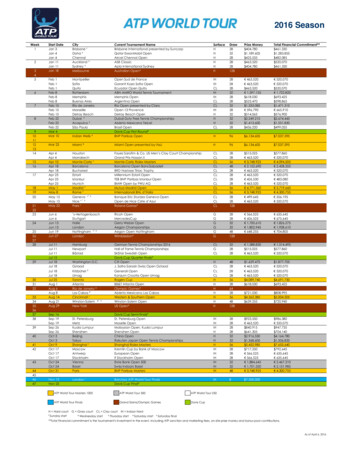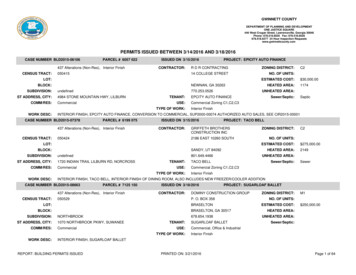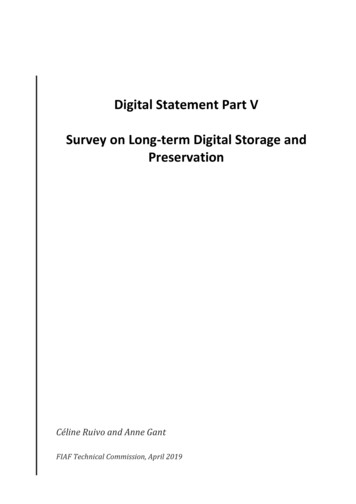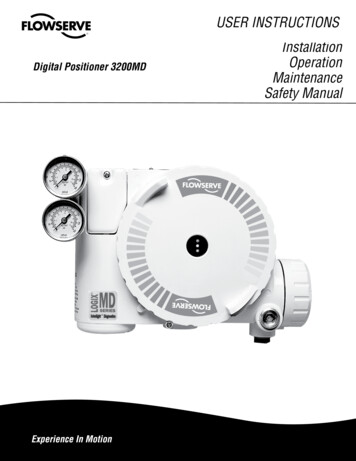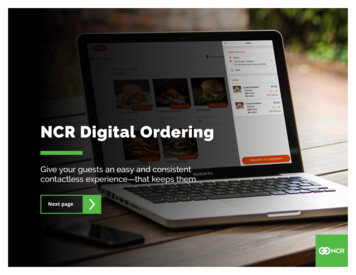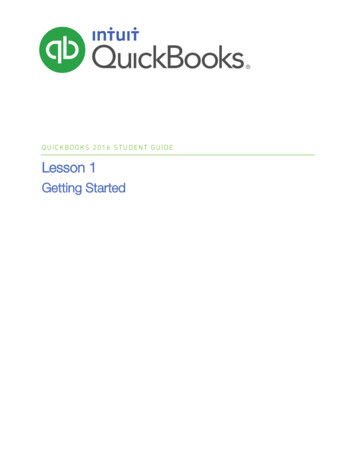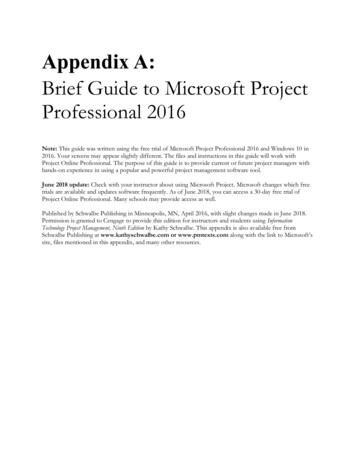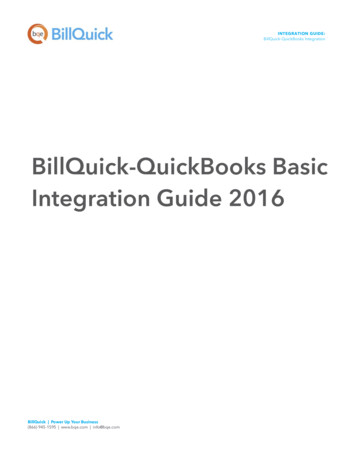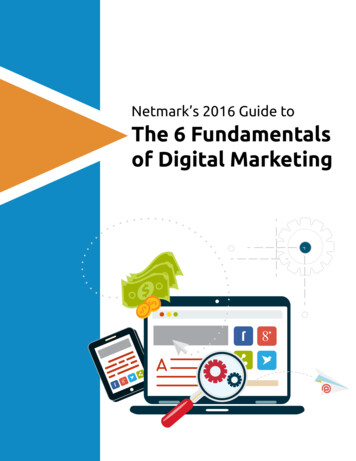
Transcription
Netmark’s 2016 Guide toThe 6 Fundamentalsof Digital Marketing
Table of ContentsIntroduction1 - A User Centered WebsiteGood HostingEffective URLStrong WebsiteUseful Content2 - SEO - Search Engine OptimizationRelevant, Useful and ImportantStart with a StrategyOptimize Your Website- Titles & Meta Descriptions- Up-To-Date Sitemap- Relevant Content- Keyword Targeting- Gain Links3 - SEM - Search Engine MarketingDifferences Between SEO & SEMKey Components for Success- Cohesive Campaigns- Relevant Ad Placement- Ad Rank & Ad Positioning — Google Ad Rank4 - SMM - Social Media MarketingBest PracticesPlatforms5 - UX Design - User Experience DesignScientific Approach6 - Email MarketingKey ElementsSpecial TricksIntroductionOver the last several years, we’ve had an opportunity to talk to tens ofthousands of companies about their online presence. In that time, we havealso seen some dramatic shifts in digital marketing strategies. When weopened our “digital doors” back in 2007, some of the techniques that workedfor our clients were very different from the majority of techniques thatwe use today. That’s because we are always adjusting and adapting to newsearch engine updates and best practices so that we can keep helping ourclients see positive results. In fact, the fundamentals may be the only thingsthat have remained constant.During our years in business, we have spent hundreds of thousands of dollarson research and data to ensure that we are always ahead of the curve,allowing us to provide quality service to our clients. Part of what we’vediscovered is that the fundamentals will always be the foundation of onlinesuccess, regardless of any new updates or design trends that pop up. Withthis in mind, we wanted to make information readily available to anyone whowants to learn more about the basics of digital marketing.The purpose of this guide is not to give you a full digital marketing strategy, itis to inform and instruct you on the key concepts of website optimization andadvertising on a basic level. This guide is meant to help those just starting outto have a sound understanding of what to know and what questions they canask as they put resources towards making their business more successful.These fundamentals will help you solve the two mostimportant questions of online marketing: How can I get more traffic to my website?How can I increase my website conversions?At Netmark, our main goal is to help businessesexperience the online success they deserve. We hopethis guide gives you a bit more direction as you striveto make your business grow.To your future success! Dan MorleyCMO, NetmarkDIGITAL MARKETINGConclusion23
A User-Centered WebsiteA User-CenteredWebsiteHaving a quality website is critical to success in the online world. After all,your website should be at the center of your online presence. If we are toliken your online presence to hosting an event, having a good website is likefinding the right location for your event. Despite all of your planning thesuccess of an event can all come down to location, location, location. Theright venue can make a good event even better and a bad venue can make anotherwise well planned event fail.If you already have a website, you should start by taking a moment and reallylooking at it. As you look at it, ask yourself some key questions. Does mywebsite serve the purpose I originally planned for it? Does it convey what thepurpose of my business is? Whom do I want to visit my online business? Am Iproviding content that those types of visitors want? What is my website reallybeing used for? These are all essential questions to ask yourself about yourwebsite in order to make sure that it is user-centered andeffective.Generally speaking, the end result of all of your workon social media, search results, and online ads is to getcustomers and potential customers to your website. Thatis because, ideally speaking, your website is where yourpotential customers can be converted into the real deal andwhere current customers can find what they are looking for.USER CENTERED WEBSITEIf you don’t have a website, we encourage you to use thefollowing steps to help your website be exactly what yourcustomers — both current and future — are looking for.However, we also encourage you to make sure that you arenot spending all of your budget on a website that nobody canfind. Hold some budget back for marketing your site.Step 1: Have Good HostingWhen it comes to your site running well, hosting makes all the difference. Inour opinion, some of the best hosting sites are: Bluehost* Go Daddy* HostGator* Amazon Web Services*4You may be wondering, what does a hosting site do? In short, they keepyour website up and running, meaning that your site cannot survive andthrive without them. The hosting platforms mentioned above have differentstrengths and weaknesses. You need to do some research todetermine which hosting service is right for you.Going back to our event analogy; strong hosting for yourwebsite is in direct correlation to the environment, location,and resources of a venue. Picking a hosting platform with theright resources for your business will set the stage for yourwebsite and business in the digital realm. Using a good venue— i.e. hosting service — makes all the difference for yourguests. In a business situation, the hosting platform will takecare of essentials like file storage, email hosting, server space,databases and more. They provide these types of resources sothat you don’t have to provide them yourself. Below we havelisted a few key metrics and questions to guide you as you findthe right hosting platform for your site.Picking a hostingplatform with theright resources foryour business willset the stage foryour website andbusiness in thedigital realm.Basic Metrics to Look For in a Hosting Company: An uptime of 99.9% — this means that your website will be up andrunning on their servers 365 days a year. Anything less can and will bedamaging to the business.Unmetered/unlimited bandwidthUnmetered/unlimited webspace or disc spaceQuality customer serviceHigh ratingsAdditional Questions to Consider: How many domains can you have?Do they support e-commerce functionality?How much does it cost?Step 2: Choose an Effective URLA URL is basically a global address for specific documents, pages, or otherresources on the World Wide Web. Put more simply, your URL is what iscommonly referred to as your website address and people use it to locate5
A User-Centered Websiteyour site. In fact, the word locater is even in the name: URL stands forUniform Resource Locater. Netmark’s URL is Netmark.com — okay, technicallyour full URL is http://www.netmark.com/ but we’re trying to keep this simple.Following these tips will help you create an effective URL.Long and/ordifficult URLs cancause problemsand introduceopportunities fortypos to land peoplein the wrong place.Make it RelevantYour URL should represent either your company name or whatvisitors will find on your website. It is common practice to useyour company name with no spaces followed by a domain namelike .com or .org. However, there are times when it makes moresense to have a URL that is related to what you do instead.Either way, your URL should be relevant to your company. If youchoose a URL that is not readily associated with your business,you may need to pursue a variety of branding opportunities toconnect your web address to your business in people’s minds— making your URL relevant to your company. Believe it or not,there was once a time when nobody know what the URL Google.com was for.Keep it Short and SimpleThere are a lot of good reasons to keep your URL short and simple. Of course,short is relative but you need to make sure that your URL is short and simpleenough to be typed without difficulty. Long and/or difficult addresses cancause problems for users and introduce opportunities for typos to landpeople in the wrong place.Things to avoid in your URL: Words or names that are difficult to spell Excessive and/or irregular repetition of letters Long strings of words Hyphens and underscoresWhen listing your URL on both physical and digital assets, you may choose tocapitalize the beginnings of words to help separate them in people’s minds.For example, if your URL is something like manywordsstrungtogether.com*,you may want to think about listing it as ManyWordsStrungTogether.com*.The capital letters won’t affect people’s ability to get to your site, but it willhelp separate the words in their minds.Make it EffectiveYour URL will be present in many different locations. In order for it to beeffective, you’ll need to think about how your URL will be used on yoursocial media platforms, on other websites, and even on signs and other6A User-Centered Websitephysical assets. As mentioned above, you may choose to use capital letters todelineate words within your URL. Whatever you decide, however, make surethat you are being consistent in your use. To really be effective, it needs tobe both clear and memorable. You should also determine if you will want topursue your URL as a keyword for search results because this will affect howyou use your URL on your site and elsewhere.Keep the User in MindIn short, you need to keep the user in mind when creating and branding yourURL. When your URL is memorable and easy to type, people are more likely tovisit your website directly because strong URLs make it easy for users to getto your site.Some Examples of Strong URLs Are: color.adobe.com* – Very simple and highly relevant to the site’s contentespecially since Adobe is already branded in most people’s minds. www.mashable.com* – Easy to remember and has beenbranded in the minds of users. www.idahofallsfamilydental.com* – This example URL hasvery strong ties to both an industry — family dentistry — anda location — Idaho Falls — making this a very strong URL.A strong, effectivewebsite should beat the center of youronline presence.Some Examples of Weak URLs Are: www.manyonline.org* – Without strong, targeted branding,most people would not associate this URL with the MuseumAssociation of New York. www.a4pt.org* – This URL is so simplified that it could lose allmeaning without strong, targeted branding. www.commoncompanyname.com* – Using a common namefor your URL gives no indication of what your company is ordoes, and can become confused with similarly named companies.Step 3: Build a Strong, Effective WebsiteAs we already mentioned, a strong, effective website should be at the centerof your online presence. All of your social media outreach, search engineresults and online advertising should be geared toward directing qualifiedtraffic to your site so that you can sell your products or services.In order to accomplish this, your website needs to be built on a strongfoundation — on a strong Content Management System (CMS). Some of7
A User-Centered Websitethe best and most commonly used CMSs are WordPress*, Wix* and Joomla*.Finding the right CMS for your website is the key to effectively managingyour time while still having a great website. Even if you know how to code,manually coding your website can drain a large amount of time and energythat could be directed more effectively elsewhere in your business. One ofthe main benefits of these CMSs is that they do most of the backgroundcoding and programming for you.office options, you’ll want to make sure that you choose a CMS that isdesigned to support these functions. This will allow your website to functioncorrectly without having to spend a lot of time on custom coding.If you don’t have any web design or coding experience, we would stronglysuggest that you have your website designed by a web design company.However, you’ll want to make sure that they build your site with a CMS thatyou can learn how to update yourself. You generally don’t wantto be responsible for making big changes to your site, but beingable to make small updates without working through a thirdpoint of party can be very beneficial under specific circumstances.Once you have the right hosting platform, a solid URL, and a strong websiteto send your users to, it’s time to fill it up with content. If we go back toour event analogy, content correlates to the drinks, appetizers, entrées,and desserts that you serve in order to satisfy your guests once they areat your venue. But you may be asking yourself, what is content? To put itsimply, content is information that you present in order to help your clientsand prospective clients. Content comes in a wide variety of forms from onpage text to infographics and videos. This section is not intended to be acomprehensive look at content marketing, but it should help you understandthe basic idea.The wholeyour CMS is to makewebsite creationeasier, not morecomplicated.Most hosting services will allow you to connect your websitedirectly to your chosen CMS, but it’s important to make sure thatyou can use the two together. The whole point of your CMS is tomake website creation easier, not more complicated.Some additional ways that a good CMS can help you include:Pre-Designed ThemesA pre-designed theme is essentially a template that can be used with aspecific CMS to build a strong, attractive website more quickly. Some of thesethemes are available for free, but most range in price from 50 to upwardof 100 depending on the developer and the features that are included inthe theme. Generally speaking, you get what you pay for so it can be a goodidea to invest in a quality theme. ThemeForest*, TemplateMonster* and WixTemplates* offer many attractive, effective, and mobile friendly templatesthat can be used to create a strong website. Many of these themes are alsodesigned to be responsive and look good on a variety of mobile devices aswell as in web browsers.CMS PluginsMost CMSs offer a variety of plugins that can be used to help you createlanding pages, slideshows, and more. Most of the plugins are quick and easyto install, but you may need to take some time to learn exactly how to use theplugins to your advantage.E-Commerce and Back Office OptionsIf your website needs to have ecommerce functionality or any other back8A User-Centered WebsiteStep 4: Create Useful ContentIn our experience, content should be used to strategically funnel yourwebsite visitors toward the actions you want them to take. To this end, wesuggest creating a variety of content that fits into different sections of whatwe call the content funnel. Each piece of content should be designed to helpyour website visitors in some way. The main portions of the content funnel —and the ways you can help your visitors — are to: InformInstructSolveSellInformInstructDepending on their needs, visitors to your siteSolvemay enter at different points in this funnel. Thebest results come when you provide content thataddresses their specific needs at the point at whichSellthey enter your funnel. Keep in mind, that users aregenerally looking for a solution to a problem and youcan provide that answer. As with any other strategic funnel, the upper levelsare designed to expose a large number of people to your information. Thetrick is to use upper level content to help create more qualified traffic to yourlower level content. Content can take a wide variety of forms, but it’s your jobto make sure that it is the relevant solution your users are looking for. And,yes, one piece of content can sometimes fill more than one of these needs.9
SEO - Search Engine OptimizationSEOSearch Engine OptimizationIf you have looked into digital marketing in recent years, it’s possible thatyou’ve heard the phrase “SEO is dead.” However, nothing could be furtherfrom the truth. Search Engine Optimization has been the lifeblood ofbeing found through search engine searches for well over a decade and itwill continue to be important for years to come. The “dead” part of SEO isattempting to manipulate the signals that search engines use for rankingsites. In recent years, Google and other search engines have caught onto these manipulated signals and worked to minimize the effect of themanipulation and/or penalize those sites that have used those practices,especially in excess.Relevant, Useful and Importantinto customers. Don’t get so stuck on rankings, specific keywords, and overalltraffic numbers that you lose sight of the overall results that can come fromyour SEO strategy.Taking it back to our event analogy, SEO is all of the planning that goes inahead of time to make sure that the event runs smoothly andthat people are aware that the event is happening so that theyDon’t get so stuckcan attend. For example, if you’re hosting a public event, youwould want to have the event fully planned and scheduledon rankings,ahead of time so that there are fewer opportunities forspecific keywords,problems to arise. You’d also need to follow applicable deadlinesand overall trafficand guidelines in order to make sure that the local newspapers,magazines, and event listings are able to publish informationnumbers that youabout your event in their events calendars so that people wholose sight of themight be interested in your event can hear about it.Start with a StrategyIn its true form, however, SEO is making sure that your website is followingspecific, best practices so that Google and other search engines can seeand rank your website. Put another way, SEO is creating orimproving your website — sometimes in ways that aren’tvisible — so that the search engines recognize it as beingrelevant, useful, and important in regards to the questionasked by a searcher.SEARCH ENGINE OPTIMIZATIONWhen a search engine thinks that your site is relevant,useful, and important to a search query, it should rank wellin the Search Engine Results Pages (SERPs). Unfortunately,SEO is not a “one and done” process. It can be a relativelyslow process at the outset and requires consistent effortto maintain. Search engines are constantly evolving, andyour SEO strategy has to be able to evolve with them. Thepower of a good SEO campaign is unbeatable, but it is a verycompetitive and fast paced environment.You should also note that successful rankings and traffic from SEO seldomhappen overnight. Instead, you will need to consistently work on your siteto make sure that everything is working properly and being seen by searchengines. Additionally, you should understand that SEO isn’t really about beingranked number one for one specific keyword. In fact, the best SEO strategiestarget many different keywords and focus on garnering better traffic, not justmore traffic for your site. Think about it, would you rather have 1000 visitorswith only 10 converting into customers or 800 visitors with 15 converting10overall results thatcan come fromyour SEO strategy.Establishing an SEO strategy is like planning your event. Themore thought you put into who you want to attend and how you’re going tolet them know about your event, the more successful you’ll be.Your SEO strategy should begin with these questions: Who is your ideal customer?Where are they located?Where do they spend their time online?What words and terms might they use to search for companies like yours?What is their likely intent behind each search query?Optimize Your WebsiteOnce you have a strategy in place, you’ll need to optimize your website.Doing so is like following the rules and guidelines established for havingyour event listed in event calendars and listings. Typically, you can’t just callthe publisher of an event calendar on the day of your event and expect itto be listed. Similarly, you can’t expect SEO to launch you to the top of thesearch results overnight. Below, we’ve provided you with some of the mostfoundational ways in which you should optimize your website to yield longterm SEO results.11
SEO - Search Engine Optimization1. Utilize Relevant Titles and Meta DescriptionsYour titles and meta descriptions are very important pieces of informationbecause they show up in the search engine results. A page’s title is theheading that shows up in the search results and it is also the name thatappears on the tab or window when you are on the page in a web browser. Ameta description, on the other hand, is the information that shows up belowthe title in search results. These two short pieces of information are generallythe first impression you get to make on a potential website visitor, so makethem count.Example:Page: Netmark’s Homepage (http://www.netmark.com/)Title: Netmark - Digital Marketing AgencyMeta Description: Netmark is a premiere digital marketing agencyspecializing in paid advertising, social media management, and website SEO.SEO - Search Engine Optimizationand other search engines to better crawl and index your site. By submittingan XML sitemap, search engines are able to discover and index all of thepages on your site more easily. When the search engines are able to crawl andindex new and updated pages on your website and blog, your organic searchrankings tend to improve.3. Have Relevant Content on Your PagesAs we’ve already discussed, having relevant content on your pages allowsyour site to be relevant to searchers’ questions. On-page content needs to bewritten and presented so that it can be used by your site’s visitors to answerthe questions they have. Search engines exist to help people find what theyare looking for on the Internet. It’s your job to make sure that the informationon your site’s pages is relevant to the questions your ideal customers arelikely to ask. Don’t write for the search engine bots though. If your contentisn’t useful to real searchers, they are unlikely to stay on your site andbecome customers.How it Appears in Search Engines:Google Result:Bing Result:You should also be aware that search engines can display alternate text fromyour page if they don’t feel that your meta description is relevant to thesearcher’s query.2. Submit an Up-To-Date SitemapA sitemap is essentially a list of all of the pages on your website. An HTMLsitemap is generally accessed via a link in the footer or header of your siteand helps visitors find a specific page that may or may not be accessiblethrough your other menus. An XML sitemap, on the other hand, helps Google124. Target Keywords That Are Relevant to Your BusinessYour on-page content should include the words and phrases thatyou want to rank for. If you want people to find your site whenthey are searching for Blue Widgets, then you’d better have thewords Blue Widgets on your site.You should be aware that while ranking for general keywordscan be a great goal, it may not be practical due to competitionlevels and varied searcher intent. Going after less competitive“long tail keywords” can actually be more productive and resultin better qualified traffic coming to your site. As an example,instead of targeting just the phrase “Blue Widgets,” you maywant to target a phrase like “Blue Widgets for sale in Your Town,USA”Going after lesscompetitive “longtail keywords” canactually be moreproductive andresult in betterqualified trafficcoming to your site.5. Work to Gain Links from High Ranking WebsitesClear back in the dark ages of the Internet (circa 1997) Larry Page and SergeyBrin wanted to find a better way to organize the seemingly infinite amountof data available on the World Wide Web so that people could find what theywere searching for. In the early days of their company — a small endeavorthey named Google — they started looking at links between websitesas votes approving of those websites. This groundbreaking idea wouldeventually become the foundation of most modern search engines.Over nearly two decades, this idea has been refined and become moredetailed and complex. Now, instead of simply counting the number of links13
SEO - Search Engine OptimizationSEMleading to a specific website, search engines also look at the quality of sitesfrom which those links originate. If the links look “spammy” or are irrelevantto the website they link to, the links will be discounted and the site possiblypenalized for low quality links. Links from a .gov or .edu domain tend to bemore trusted than those coming from more general domaintypes like .com because entities have to prove who they are inorder to get these types of domains. Nevertheless, .com sitesSites that are wellthat are well established and trusted by the search engines alsohave more weight when it comes to their links.established andtrusted by thesearch engines havemore weight when itcomes to their links.As illustrated in the graphic below, large numbers of links canboost your importance but so can a smaller number of linksfrom trusted and well established sites. In essence, getting linksfrom high ranking and trusted websites is like bringing a popularfriend or friends with you to a party: you’re cool by associationand the host’s estimation of your popularity is increased.Search Engine MarketingSearch Engine Marketing (SEM) is a blanket term used to describe a varietyof online advertising efforts. Like SEO, it is used to attract users to your sitewho will find your offerings valuable to them. When people think of SearchEngine Marketing, they usually only think of the ads that are placed at the topand to the right of search engine results in search engines like Google andBing. However, the term is also commonly used to refer to paid advertisingon social platforms like Facebook, YouTube, Google and Pinterest; on manywebsites; in many apps and throughout the digital world.This type of online marketing is also commonly referred to as Pay-Per-Click(PPC) advertising because you generally pay a certain amount each timesomebody clicks on your ad, although there are also options for paying perthousand impressions on many online ad platforms.Whether you’re referring to paid online advertising as SEM or PPC, there aresome key elements you should understand before you get started.Differences Between SEO & SEMLet’s start with some key differences between SEO and SEM.As we discussed above, SEO is used to get your website torank in the regular search engine results, commonly calledorganic search results in the digital marketing industry.Conversely, SEM is paying to place your ads with your websiteinformation in specific locations, including above or next tosearch engine results.Both the organic and the paid sides of search results canbe highly competitive, but they offer very different valuepropositions. For example, while SEO tends to be highlyeffective in the long term, it can take 6 to 12 months —SEARCH ENGINE MARKETINGor even more depending on competition levels — to seeconsistent results from your SEO efforts. You also mustcontinue to optimize and refresh your online presencein order to maintain rankings. With SEM, on the other hand, you can seeplacement of your listing almost immediately but maintaining that placementrequires upkeep and a constant infusion of money.One of the best analogies we’ve heard for the difference between SEO and1415
SEM - Search Engine MarketingSEM is to think of it like losing weight via diet and exercise or via plasticsurgery. SEO, like losing weight through diet and exercise, takes time to beeffective, requires constant attention to details, and still requires work tomaintain once the desired results have been achieved. SEM is more like usingliposuction to take the pounds off. The results are fast and dramatic, butrequire money and constant upkeep in order to be maintained.Key Components of SEMSEM is a simple idea that can have complex implementation. While we don’thave the time to delve into all of the specifics of SEM implementation, let’slook at some of the key components that can make your paidonline marketing efforts a success.“The Princess Theoryrefers to a little girl’sprincess-themedbirthday party Everything matchesthe theme. Similarly,your AdWords,ad groups, andcampaign as a wholeneed to match thesame theme.”– Chris Parrett,SEM SpecialistCohesive CampaignsWhen you work in SEM, as in traditional advertising, you workin campaigns. A campaign is simply a series of ads that share acommon theme and are designed to work together. In SEM, youcreate your ad campaigns to target specific, relevant keywords.The most effective campaigns are cohesive; they tie everything— your keywords, your ad groups, etc. — together so that youaren’t putting out conflicting messages with your ads.Here at Netmark, we sometimes call this the Princess Theory.Chris Parrett, one of our SEM Specialists, says that “The PrincessTheory refers to a little girl’s princess-themed birthday party.Everything — from the decorations to the cake to the partyfavors — matches the theme. Similarly, your AdWords, adgroups, and campaign as a whole need to match the sametheme.”Relevant Ad PlacementAnother way to make sure that your ads are as successful aspossible is to make sure that your ad is relevant to where it isbeing placed. Going back to our event analogy, placing fliers fora golf tournament in a sporting goods shop is likely to yield better resultsthan placing them in a sewing machine store. Of course, you want people toclick on your ads. But, ultimately, you want people to see and click on your adwho are interested in your solution. What you have to understand is that itdoesn’t matter how many people see your ad if the people who see your adaren’t interested in what you have to offer.16SEM - Search Engine MarketingThe best ad placements are contextual to what the person seeing the ad isdoing, seeing or reading at that time. Think of the last time you were lategetting to the theater. You probably didn’t miss the beginning of your movie,but you may have missed some of the previews. Were you disappointedat missing the previews? If not, do you know someone who would be? Theanswer is probably yes. However, the question that arises is, why? Why wouldsomebody be disappointed when they miss movie trailers? Afterall, they’re just ads.The answer may surprise you. Most people don’t like to miss
4 - SMM - Social Media Marketing Best Practices Platforms 5 - UX Design - User Experience Design Scientific Approach 6 - Email Marketing Key Elements Special Tricks Conclusion Introduction Over the last several years, we’ve had an opportunity to talk to tens of thousands of companies about thei

